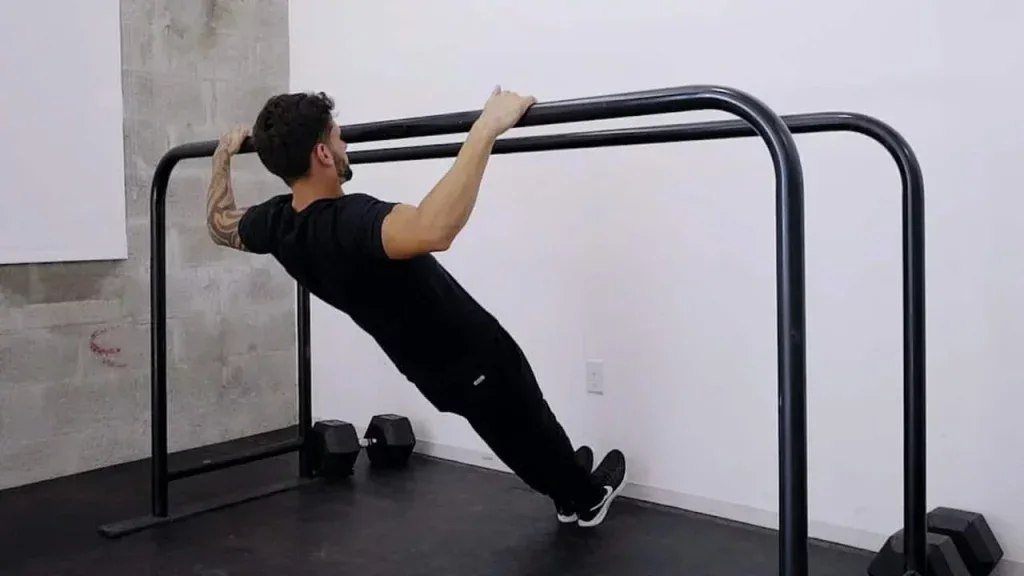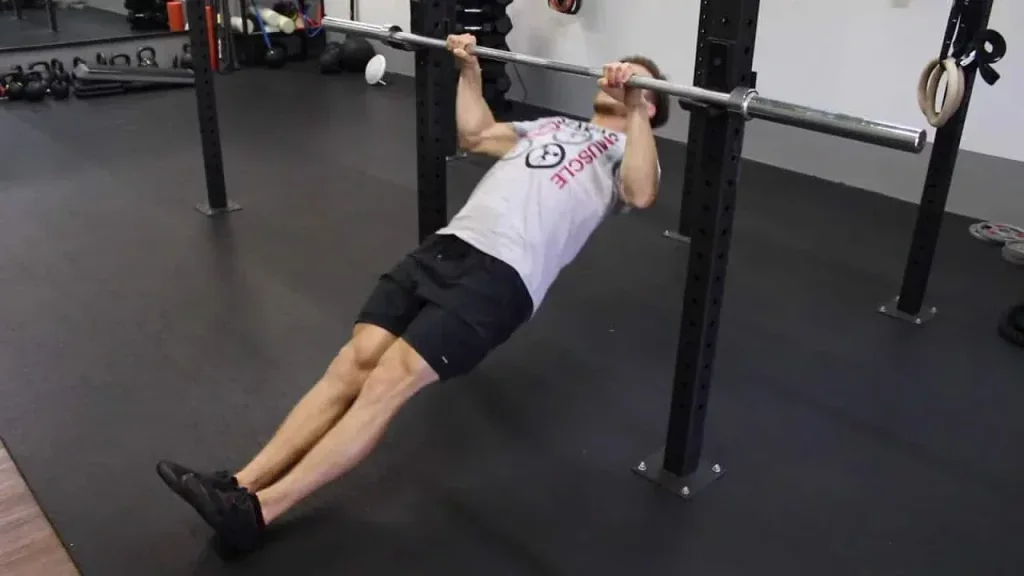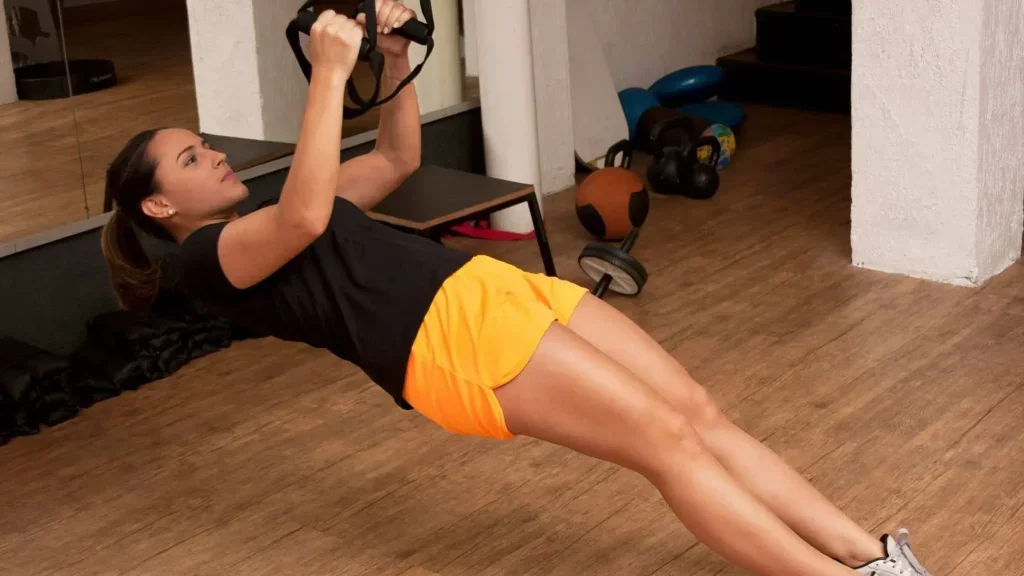Physical Address
304 North Cardinal St.
Dorchester Center, MA 02124

Does the idea of doing a regular pull-up feel like climbing Mount Everest?
Don’t let the challenge intimidate you! We have a stepping stone that might be just right for you.
Welcome to the world of Australian Pull Up, the unsung heroes of bodyweight exercises.
Also known as Inverted Rows or Bodyweight Rows, Australian Pull-Ups are not only accessible for beginners, but they also offer a fantastic upper body workout.
In this guide, we’ll unlock the secrets of the Australian Pull-Up, from its multitude of benefits to techniques and variations.
So, lace up your sneakers, grab your workout gear, and get ready to conquer a new fitness milestone with the Australian Pull-Up!
Table of Contents
Australian pull-up is one of the best calisthenic exercise for those who are working to a standard pull-up. It is also called as horizontal pull-up or bodyweight row or inverted row. Australian also involves in “down under” which is above the waist height and feet rest on the ground.
Australian Pull-ups is to work for the upper body, the muscles of the back, abs, and biceps. The pullup training is amazing as the body works against the gravity. Pull-ups are good to pull against the resistance and avoid pitfalls. It is done in the best way at the waist-height bar.
• Pull-ups difficulty level is intermediate.
• It focuses on strength
• The muscles that involve in the exercise are Back, Shoulders, Biceps, and Abs
• The equipment used is Pull-up Bar.
Australian pull up or more commonly known as Inverted Row or Bodyweight Rows are one of the best ways to strengthen your back muscles. It works on all the major back muscles that we are going to discuss later in the article.

Inverted row is a great exercise to progress towards the regular pull ups if your body lacks the strength to perform them. It is a calisthenics exercise that majorly works on upper body, the back muscles but the entire body gets the benefits Australian pull ups have to offer. And the best part of this exercise is that you can challenge the entire body without the need for any equipment or gym membership.
The unusual movement involved in the Australian pull-up will also add a fun element to your routine. It can be performed at the start of your workout routine and or at the end, to complete the session with a full body workout.
In this post, we will discuss the technique involved in Australian pullup and how to master it, the muscle group this exercise works on, the benefits of Australian pull ups, who should do it and how much should it be done, and its comparison with a regular pushup.
Mastering Australian Pull Ups necessitates a keen understanding of proper technique and form. This not only ensures you get the most out of your workout but also minimizes the risk of injury. Here’s a step-by-step guide to getting it right.
To start, you’ll need a pull-up bar set at a little over waist height or approximately one and a quarter meters high. Place yourself under the bar, aligning your body correctly to maintain a straight line between your back, hips, and heels throughout the exercise.
1. Grip and Positioning Grasp the bar with straight arms, a little wider than shoulder-width apart. Your body should be aligned under the bar, heels on the ground, and your torso, glutes, and legs forming a straight line. If you struggle to maintain balance, you can keep your feet a bit wider; otherwise, keep them closer together.
2. The Pull-Up As you initiate the pull-up, aim for an angle of roughly 45 degrees from your heels and exhale. Pull yourself up until your chest is almost touching the bar, keeping your core and glutes engaged and tight throughout.

While Australian Pull Ups might seem simple at first glance, maintaining proper form can be a challenge, particularly for beginners. Here are some essential tips to ensure your form is on point:
1. Don’t Rush Take your time with each repetition. A hurried pull-up can lead to improper form and potential injury. By maintaining a steady pace, you ensure that each muscle group is engaged correctly and efficiently.
2. Core Engagement While it might be tempting to focus solely on your upper body, remember to keep your core engaged throughout the exercise. This not only provides stability but also works your abs, making the Australian Pull Up a more comprehensive exercise.
3. Protect Your Neck It’s easy to forget about your head position during the exercise. To avoid strain, keep your neck neutral—don’t let your head hang down or push it excessively upward.
By following these techniques and focusing on form, you can maximize the benefits of Australian Pull Ups and boost your fitness progress safely and effectively.
Australian Pull-Ups, a versatile bodyweight exercise, offer more than just an accessible stepping stone towards achieving regular pull-ups. They serve as a comprehensive workout, targeting a multitude of muscle groups, providing a robust strength training routine right at your fingertips.
The primary muscles worked during Australian Pull-Ups are those in your back. This includes the Latissimus Dorsi, also known as the ‘lats,’ which span across your lower back, and the Trapezius muscles that extend down the back of your neck and upper spine.
Both muscle groups are paramount for posture and daily functional movements.
Further contributing to the back muscles worked are the Rhomboids and Deltoids. The Rhomboids, located in the upper back between your shoulder blades, help bring them together. The Deltoids, wrapping over the shoulder joints, are crucial for any pulling movements and shoulder stability.
Additionally, Australian Pull-Ups also work on several other muscles. The Biceps Brachii, located in the upper arm, and the Brachialis, an often-overlooked muscle located underneath the biceps, are heavily engaged. These muscles worked together give you pulling strength and well-defined arms.
But the list of muscles worked doesn’t end here. Your core, including the Rectus Abdominis and Obliques, is engaged to maintain your body alignment during the exercise. This engagement leads to improved balance, stability, and a stronger midsection.
Finally, even though they’re not the primary focus, your glutes and leg muscles receive a mild workout as they contract to keep your body stable during the movement.
In summary, Australian Pull-Ups offer a comprehensive workout, with numerous muscles worked simultaneously. From the dominant muscles of your back and arms to the stabilizing muscles of your core and legs, it’s an all-around exercise that contributes significantly to overall strength and functional fitness.
If you are an absolute beginner and think that performing it’ll be difficult or you to perform Australian Pull Up or incline pull up then there are two different modifications you can adopt.
a. Fixing the bar at a lower height and keeping the hips and legs on the ground. This is a great way to reduce the exercise difficulty like knee pushup when you are not able to perform a regular push up.
b. The next variation is by performed by bending the knees and keeping the feet on ground rather than the heels. This variation is little more difficult than the previous one and more muscles get worked in this.
c. You can also try the underhand grip that’d focus more on the bicep muscles.
Once, you are able to perform regular Australian pull ups it’s time to introduce some difficulty level to make it more challenging to reap the maximum benefits of the exercise.
There are three ways that can be used to increase the difficulty level for the exercise.
a. By wearing a weighted vest.
b. By elevating the feet higher.
c. By extending the time to perform a repetition.
Australian pull up offers slightly different benefits from the regular pull ups or chin ups as the range of motion to perform this exercise works on the muscles differently.
Embark on the journey of bodyweight workouts with the multifaceted Australian Pull Ups. Simple to perform yet highly impactful, this exercise unfolds an array of benefits that could dramatically redefine your fitness journey. Let’s dive into the myriad advantages you can reap from Australian Pull Ups.
1. All-In-One Fitness Package: Australian Pull Ups transcend the boundaries of a regular upper body workout. These exercises recruit a variety of muscle groups, from your core to your lower body, crafting an exhaustive fitness routine within a single move.
2. Backbone of Strength: Your back muscles receive a major boost from Australian Pull Ups. By targeting areas like the latissimus dorsi, trapezius, rhomboids, and deltoids, these exercises fortify your back, enhancing posture and aesthetics.
3. Power for Practicality: Australian Pull Ups, with their multilateral muscle engagement, amplify your functional strength, essential for everyday tasks involving lifting, pulling, or pushing.

4. Grip Power Unleashed: Being a bodyweight pulling exercise, Australian Pull Ups can significantly enhance your grip strength, improving overall performance in other workouts and day-to-day tasks.
5. Boosting Muscle Tenacity: Regular sessions of Australian Pull Ups, especially with increasing repetitions, can help enhance your muscular endurance, enabling you to perform better during prolonged physical exertion.
6. Beginners’ Best Bet: Unlike traditional pull-ups, Australian Pull Ups are an accessible starting point for fitness beginners, paving the way towards more advanced pulling exercises.
7. A Pathway to Progress: As your fitness proficiency increases, you can diversify or intensify your Australian Pull Ups, keeping the challenge alive and your muscle growth and strength on an upward trajectory.
Australian Pull Ups are more than an exercise—they’re a comprehensive strategy for body transformation. They’re a beacon of strength, endurance, and holistic fitness that definitely deserves a spot in your workout routine.
As we delve into the nuances of various exercises, it’s essential to compare Australian Pull Ups with other closely related exercises. This comparison will provide a clearer understanding of their benefits, enabling us to make informed decisions about our fitness routines.
Intensity: Traditional Pull Ups are more intense than their Australian counterparts, as they demand more upper body strength and control. However, this intensity makes them a more challenging workout, particularly for beginners.
Muscle Engagement: While both exercises work similar muscle groups, Traditional Pull Ups tend to focus more on the latissimus dorsi (lats) and the biceps. Australian Pull Ups, on the other hand, provide a more balanced distribution of work across multiple muscle groups.
Exercise Position: The most significant difference between Inverted Rows and Australian Pull Ups lies in the body’s position relative to the ground. Inverted Rows are performed horizontally under a fixed bar, while Australian Pull Ups involve a semi-vertical stance. This difference alters the muscles’ engagement, with Inverted Rows targeting the mid-back muscles more directly.
Difficulty Level: Australian Pull Ups can be more challenging than Inverted Rows because they require more core stability and upper body strength.
Grip: The key difference between Australian Pull Ups and Chin Ups is the grip. While the former uses an overhand grip, the latter involves an underhand grip. This minor change drastically alters the muscles worked, with Chin Ups engaging the biceps more prominently.
Accessibility: Similar to Traditional Pull Ups, Chin Ups are more challenging due to their vertical position, making Australian Pull Ups more accessible for beginners.
By understanding these subtle yet important differences, you can select the right exercises to meet your specific fitness goals and requirements. Remember, every exercise offers unique benefits, and variety is the key to a balanced and effective workout regimen.
In the dynamic realm of fitness, understanding and executing the correct exercise techniques can be a game-changer. The Australian Pull Up, a versatile and accessible exercise, stands out as an exceptional tool in your fitness arsenal. Whether you’re a beginner on your fitness journey or an advanced athlete seeking to diversify your routine, this exercise offers numerous benefits.
The Australian Pull Up’s ability to target multiple muscle groups simultaneously offers you a comprehensive upper-body workout. Furthermore, its flexibility in form, grip, and execution ensures it can be adapted to meet individual fitness levels and goals.
Comparing Australian Pull Ups with other related exercises such as Traditional Pull Ups, Inverted Rows, and Chin Ups, we see that each exercise, while similar in some aspects, offers unique benefits and challenges. Selecting the appropriate exercise should be based on your fitness level, goals, and the specific muscle groups you want to target.
Remember, the most important aspect of any workout regimen is consistency. Mastering the Australian Pull Up won’t happen overnight. It will require patience, persistence, and practice. However, once you’ve got the hang of it, the benefits in terms of strength, endurance, and overall body conditioning will be well worth the effort.
In conclusion, the Australian Pull Up is more than just an exercise; it’s a stepping stone towards more advanced workouts, a test of your physical prowess, and a testament to your commitment to health and fitness. So, go ahead and embrace the challenge – your body will thank you!